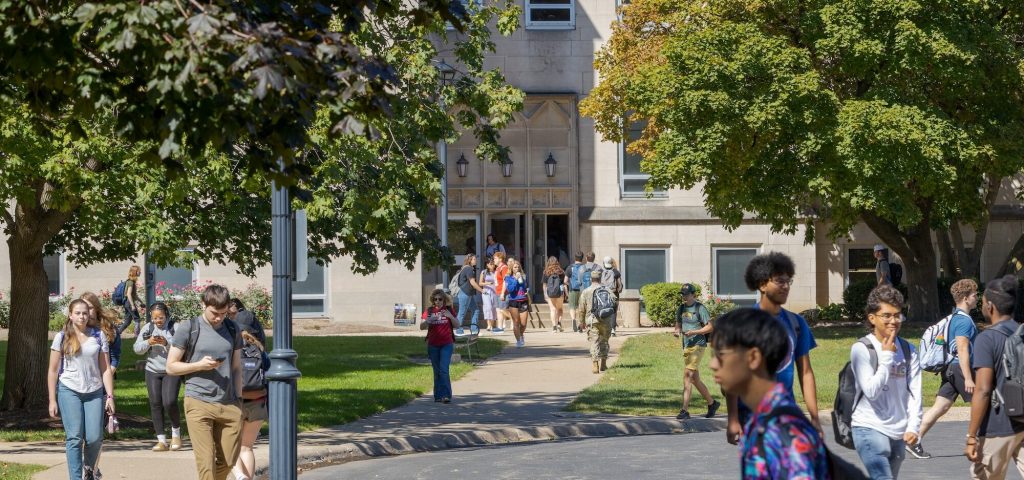
College enrollment numbers nationwide are declining, and Bradley is no exception.
According to a news release on Sept. 23, the university welcomed 1,064 new students for the fall semester. This includes just 642 freshmen, 150 transfer students, 119 online students and 153 graduate students.
These numbers are low, but as the latest contribution to a downward trend, they were expected. University leaders entered the semester prepared to address enrollment concerns.
“We’ve known the demographic shifts were coming, so while the numbers are concerning, they aren’t surprising,” Angie Cooksy, Vice President for Enrollment Management, Marketing and Communications, said. “What matters now is how we respond, and I’m confident in the strategic actions Bradley has already taken and will continue to take to position ourselves for growth.”
These expectations stem from the enrollment cliff: a predicted 15 percent decrease in college-aged students between 2025 and 2029, particularly in the United States, due to decreased birth rates during the Great Recession of 2008.
As Bradley teeters on the edge of this so-called cliff, so does higher education as a whole.
“Higher education is facing unprecedented headwinds,” Cooksy said. “Fewer high school graduates, increased competition and more families questioning the value of college. I recognize that in a shifting landscape, it is more important than ever to adapt, and that’s exactly what we’re doing at Bradley.”
As the university adapts, enhancing student experience is a priority. The three-year degree tracks launched this semester offer students more flexibility, aiming to save them time and money if they wish.
Additionally, Bradley bolstered its admission and marketing teams over the past year and secured millions of dollars in funding for campus improvements.
These changes have not gone unnoticed by current students.
“This year, I’ve seen that they’ve really invested in the campus, like [by renovating] Williams Dining Hall; that’s been big for our campus in terms of having a place that’s actually nice to eat and study,” Claire Moody, a senior psychology major, said.
“Also, adding things here and there like lecture halls; I thought that was pretty awesome because I use them,” Moody added. “They’ve updated a lot on campus, and it’s nice to see that they’re investing in the students.”
Not all students are concerned with the university’s efforts to improve enrollment. Some, like freshman communications major Natalie Hall, chose Bradley for its intimate community.
“Bradley stood out because of its small atmosphere and opportunities in my major,” Hall said. “I felt like I was going to be personally supported here and would have the opportunity to make a name for myself.”
Smaller classes often provide students with more hands-on experiences and professional connections.
“Our average class size here at Bradley is 17,” Delaney Giles, a senior sports communications major, said. “It’s really helpful when you take a second to think about it, because you get the opportunity to get to know your classmates, get to know your professors … the professors know you by name, which is huge.”
Even so, higher education relies on having people to educate, and outside of class, campus clubs and organizations suffer from having too few participants.
As vice president of Epsilon Sigma Alpha (ESA), a service sorority, Moody has noticed the effects of the enrollment cliff firsthand.
“Our entering pledge class this year is only nine people, while in comparison, last year it was 13,” Moody said. “And maybe people aren’t interested in service–that’s totally fair–but with a smaller class size, it’s definitely harder to get high numbers in any sort of club … 600 people can only go around so much.”
To alleviate worries like these, Bradley implemented a unified Strategic Enrollment Plan, which serves as a roadmap to growth. The three-year Strategic Enrollment Planning Task Force, co-chaired by Cooksy and Interim Provost Dan Moon, had its first meeting on Sept. 9.
B-News will post regular updates as this initiative progresses, and the university will continue to focus on academic innovation and student success.
“Enrollment impacts the entire university. It affects budgets, campus vibrancy and even the local economy,” Cooksy said. “So it’s natural for community members to be concerned. My response is this: we hear those concerns, we share them, and we are taking action. We are not standing still.”
